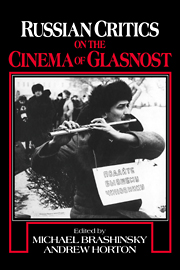Book contents
- Frontmatter
- Contents
- Acknowledgments
- Introduction
- Part One Films in a shifting landscape
- Part Two Glasnost's top ten
- I Repentance
- II Is It Easy To Be Young?
- II A Forgotten Tune for the Flute
- IV The Cold Summer of '53
- V Assa
- VI Commissar
- VII Little Vera
- VIII The Days of Eclipse
- IX The Needle
- X Taxi Blues
- Conclusion
- Directors' biofilmography
- Filmography
- About the contributors
- About the editors
- Index
II - Is It Easy To Be Young?
Published online by Cambridge University Press: 04 August 2010
- Frontmatter
- Contents
- Acknowledgments
- Introduction
- Part One Films in a shifting landscape
- Part Two Glasnost's top ten
- I Repentance
- II Is It Easy To Be Young?
- II A Forgotten Tune for the Flute
- IV The Cold Summer of '53
- V Assa
- VI Commissar
- VII Little Vera
- VIII The Days of Eclipse
- IX The Needle
- X Taxi Blues
- Conclusion
- Directors' biofilmography
- Filmography
- About the contributors
- About the editors
- Index
Summary
In a sharply polemic manner, the creators of this feature documentary enter into an open dialogue with young Latvians. The range of questions discussed varies from juvenile delinquency to the Afghan war. The questions are dramatized by inability or lack of desire on the part of the older generation to understand its children's problems and conflicts.
Is It Easy To Be Young? [Legko li byt’ molodym?}. Directed by Juris Podnieks; screenplay by Abram Kletskin, Yevgeny Margolin, and Juris Podnieks; cinematography by Kalvis Zaltsmanis; music by Martinsh Brauns. Color, 83 min. Riga Film Studios production, 1986.
2. The unpopular Afghan War, which left its veterans physically and spiritually crippled, is just one of the previously forbidden youth problems discussed in Juris Podnieks’ pioneering feature documentary Is It Easy To Be Young? (1986). (Photo: Kinocenter and Sovexportfilm.)
A public discussion was scheduled after the screening. (As far as I know, it was the first preview of Is It Easy To Be Young? [1986]) The director, Juris Podnieks, held the show at the Moscow Physicists’ Club.
Scarcely had the screening ended and the chairman called for comments when a cry was heard, “May I ask the director a question?” – “Yes, you may.” – “Do you consider yourself a naive person?” Juris Podnieks braced himself and answered after a pause with an icy voice, “No, I don't.” The questioning continued, “I wonder what you were thinking about? Do you really think this kind of film will ever be released?”
A woman sitting next to Podnieks (she, in fact, was the one who had arranged the session) stood up and began to speak quickly in an agitated tone, as if in a hurry to end …
- Type
- Chapter
- Information
- Russian Critics on the Cinema of Glasnost , pp. 61 - 68Publisher: Cambridge University PressPrint publication year: 1994



